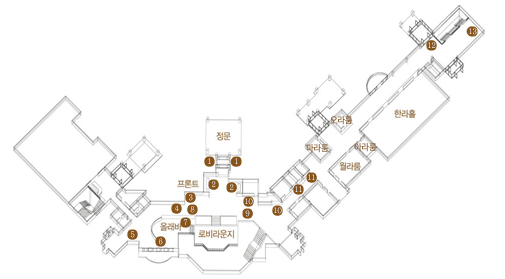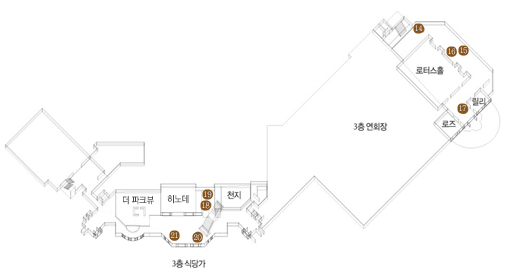Activities
Current location : > Activities > Gallery Tour > Gallery Tour

Beyond rest and relaxation, The Shilla Jeju provides an experience of “Prestigious Culture” for our guests.
Cultural experience extends well beyond the simplicities of daily life, and involves appreciating the unique values that live deeper in our world. The lobby and hallways of The Shilla Jeju are adorned with more than 40 impressive works of renowned local and overseas artists.
This gallery tour will offer you artistic inspirations from some of the best artists, and will be remembered as one of the most relaxing experiences during your stay at The Shilla Jeju.
THE SHILLA SEOUL
Hotel Shilla Co., Ltd. 3039-3, Saekdal-dong, Seogwipo-si, Jeju-do, Korea
- Introduction
- Hotel overview
- Fact Sheet
- Floor Information Map
- 오시는길
- 고객문의
- Contact Number
- FAQ
- 문의하기

















![1. Han Jin-Seob [Standing girl and boy sculpture]](/images/contents/activ/GAT/R00000009FIM_EN.jpg)
![2. Park Young-Nam [Gogh&Mondrian V, VI]](/images/contents/activ/GAT/R00000009FIU_EN.jpg)
![3. Kim Chang-Yeol [Water drop]](/images/contents/activ/GAT/R00000009FIW_EN.jpg)
![4. Choi Jong-Tae [Face]](/images/contents/activ/GAT/R00000009FIY_EN.jpg)
![5. Yu Ui-Rang [Flowers and Trees]](/images/contents/activ/GAT/R00000009FJ0_EN.jpg)
![6. Hyun Hye-Sung [Sea Story]](/images/contents/activ/GAT/R00000009FJ2_EN.jpg)
![7. Kim Dong-Woo [Performing lover]](/images/contents/activ/GAT/R00000009FJ4_EN.jpg)
![8. Arman [Bayadere (Dancer)]](/images/contents/activ/GAT/R00000009FJ6_EN.jpg)
![9. Salvador Dali [Space Venus]](/images/contents/activ/GAT/R00000009FJ8_EN.jpg)
![10. Kim Heung-Joo [Untitled]](/images/contents/activ/GAT/R00000009FIK_EN.jpg)
![11. Ahn Byung-Suk [The wind]](/images/contents/activ/GAT/R00000009FIN_EN.jpg)
![12. Jun Gook-Gwang [Origin of Life]](/images/contents/activ/GAT/R00000009FIP_EN.jpg)
![13. Bang Hye-Ja [Light of Cell 1, 2]](/images/contents/activ/GAT/R00000009FIR_EN.jpg)

![1. Han Jin-Seob [Standing girl and boy sculpture]](/images/contents/activ/GAT/R00000009FHF_EN.jpg)
![2. Park Young-Nam [Gogh&Mondrian V, VI]](/images/contents/activ/GAT/R00000009FHU_EN.jpg)
![3. Kim Chang-Yeol [Water drop]](/images/contents/activ/GAT/R00000009FHX_EN.jpg)
![4. Choi Jong-Tae [Face]](/images/contents/activ/GAT/R00000009FI0_EN.jpg)
![5. Yu Ui-Rang [Flowers and Trees]](/images/contents/activ/GAT/R00000009FI3_EN.jpg)
![6. Hyun Hye-Sung [Sea Story]](/images/contents/activ/GAT/R00000009FI6_EN.jpg)
![7. Kim Dong-Woo [Performing lover]](/images/contents/activ/GAT/R00000009FI9_EN.jpg)
![8. Arman [Bayadere (Dancer)]](/images/contents/activ/GAT/R00000009FIC_EN.jpg)
![9. Salvador Dali [Space Venus]](/images/contents/activ/GAT/R00000009FIF_EN.jpg)
![10. Kim Heung-Joo [Untitled]](/images/contents/activ/GAT/R00000009FHI_EN.jpg)
![11. Ahn Byung-Suk [The wind]](/images/contents/activ/GAT/R00000009FHL_EN.jpg)
![12. Jun Gook-Gwang [Origin of Life]](/images/contents/activ/GAT/R00000009FHO_EN.jpg)
![13. Bang Hye-Ja [Light of Cell 1, 2]](/images/contents/activ/GAT/R00000009FHR_EN.jpg)
![14. Lee Il-Ho [Color is in vain]](/images/contents/activ/GAT/R00000009FGU_EN.jpg)
![15. Lee Wal-Jong [Middle path of life]](/images/contents/activ/GAT/R00000009FGY_EN.jpg)
![16. Hyun Hye-Sung [Scent of inner mind]](/images/contents/activ/GAT/R00000009FH0_EN.jpg)
![17. Chun Byung-Hun [Enemy-1998]](/images/contents/activ/GAT/R00000009FH2_EN.jpg)
![18. Yu Ri-Ji [Market for resting space]](/images/contents/activ/GAT/R00000009FH4_EN.jpg)
![19. Park Dae-Sung [Ilchulbong]](/images/contents/activ/GAT/R00000009FH6_EN.jpg)
![20. Han Jin-Seob [New born]](/images/contents/activ/GAT/R00000009FH8_EN.jpg)
![21. Han Jin-Seob [Sound of Spring]](/images/contents/activ/GAT/R00000009FHA_EN.jpg)



![14. Lee Il-Ho [Color is in vain]](/images/contents/activ/GAT/R00000009FFT_EN.jpg)
![15. Lee Wal-Jong [Middle path of life]](/images/contents/activ/GAT/R00000009FG2_EN.jpg)
![16. Hyun Hye-Sung [Scent of inner mind]](/images/contents/activ/GAT/R00000009FG5_EN.jpg)
![17. Chun Byung-Hun [Enemy-1998]](/images/contents/activ/GAT/R00000009FG8_EN.jpg)
![18. Yu Ri-Ji [Market for resting space]](/images/contents/activ/GAT/R00000009FGB_EN.jpg)
![19. Park Dae-Sung [Ilchulbong]](/images/contents/activ/GAT/R00000009FGE_EN.jpg)
![20. Han Jin-Seob [New born]](/images/contents/activ/GAT/R00000009FGH_EN.jpg)
![21. Han Jin-Seob [Sound of Spring]](/images/contents/activ/GAT/R00000009FGK_EN.jpg)



![22. Hyun Hye-Sung [Sound of Forest]](/images/contents/activ/GAT/R00000009FK0_EN.jpg)
![23. Kim Su-Hyun [Prayer]](/images/contents/activ/GAT/R00000009FK2_EN.jpg)
![22. Hyun Hye-Sung [Sound of Forest]](/images/contents/activ/GAT/R00000009FJS_EN.jpg)
![23. Kim Su-Hyun [Prayer]](/images/contents/activ/GAT/R00000009FJV_EN.jpg)




